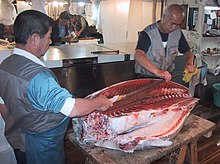Streptococcus iniae
| Streptococcus iniae | |
|---|---|

| |
Phase contrast micrograph of S. iniae colonies stained with streptavidin-FITC
| |
| Scientific classification | |
| Domain: | Bacteria |
| Phylum: | Bacillota |
| Class: | Bacilli |
| Order: | Lactobacillales |
| Family: | Streptococcaceae |
| Genus: | Streptococcus |
| Species: | S. iniae
|
| Binomial name | |
| Streptococcus iniae Pier, 1976[1]
| |
| Synonyms | |
|
Streptococcus shiloi (Eldar, 1994) | |
Streptococcus iniae is a
S. iniae has occasionally produced infection in humans, especially fish handlers of Asian descent. Human infections include sepsis, toxic shock syndrome, and inflammation of the skin, intervertebral discs, or inner layer of the heart. Identifying S. iniae in the laboratory can be difficult, since the conventional methods used to identify streptococci yield insufficient results. It cannot be grouped by the Lancefield antigen method typically used to categorize Streptococcus species. The two known serotypes can be distinguished biochemically by differences in enzyme activity. Several antibiotics have been used to treat S. iniae infections.
History
Streptococcus iniae was first isolated in 1972, from subcutaneous abscesses in a captive specimen of Amazon river dolphin (Inia geoffrensis) suffering from an infection known as "golf ball disease". The bacterium was found to be sensitive to beta-lactam antibiotics, and the dolphin was treated successfully with penicillin and tylosin. The causative organism was recognized to be a new species of Streptococcus, and was given the name Streptococcus iniae in 1976.[1] Around this time, other streptococcal outbreaks occurred in Asia,[2][3] and the US;[4] some strains associated with the Japanese outbreaks[2][3][5] were later suggested to be S. iniae.[6]
In the 1980s, a purported new species of Streptococcus, named S. shiloi, was identified as one of the causes of an epidemic of
Identification

(left) α-hemolysis; (middle) β-hemolysis; (right) γ-hemolysis (= nonhemolytic)
S. iniae may be easily misidentified (or not identified at all) by conventional automated microbiology systems.
S. iniae is
Serotypes
Two
Role in disease
In fish

S. iniae is highly pathogenic in
The site of S. iniae infection and its clinical presentation vary from species to species. In tilapia, S. iniae causes meningoencephalitis, with symptoms including
In humans

S. iniae can cause
Control and treatment
Several measures can be taken to control infection in aquaculture once an S. iniae outbreak has been confirmed. Decreasing the quantity of feed given to fish has been shown to reduce mortality rates, as the uptake of bacteria in water is expedited by feeding. Decreasing the density of the fish stock increases survival by reducing injury to fish and lowering the general stress level in the population. Lowering the water temperature and keeping optimal oxygen levels has also been shown to reduce stress to fish and inhibit bacterial growth.[33]
A 2005 study showed the potential for using
Several antibiotics have been used successfully to treat S. iniae infection in fish. Enrofloxacin, a quinolone antibiotic, has been used to great effect in hybrid striped bass (Morone chrysops × M. saxatilis), although evidence suggested the development of a resistant strain during this trial.[42] Amoxicillin, erythromycin, furazolidone, and oxytetracycline have also been used (the last with varying success, only in barramundi).[27] Vaccination against S. iniae has been attempted with limited success as it only provides up to 6 months' immunity.[27][43]
References
- ^ ]
- ^ .
- ^ .
- .
- .
- ISBN 978-0-632-03497-0.
- S2CID 42385454.
- PMID 25097961.
- ^ PMID 15695711.
- ^ PMID 9758844.
- ]
- PMID 10618129.
- PMID 18353022.
- ^ PMID 9271480.
- ^ PMID 12624022.
- .
- ^ PMID 9228748.
- PMID 12364372.
- PMID 12450798.
- PMID 8769472.
- ^ PMID 9650992.
- ]
- PMID 11472962.
- PMID 12691195.
- ^ PMID 15648844.
- ^ Google Book Search.
- ^ PMID 17418985.
- PMID 17718161.
- PMID 10401583.
- .
- PMID 17132470.
- .
- ^ .
- .
- PMID 12113301.
- PMID 11131554.
- ^ Google Book Search.
- ^ "Invasive Infection with Streptococcus iniae—Ontario, 1995–1996". Morbidity and Mortality Weekly Report (MMWR). Centers for Disease Control and Prevention. 1996-08-02. Retrieved 2010-03-06.
- PMID 17761491.
- PMID 15503411.
- ^ PMID 16336470.
- .
- ^ Streptococcosis – Fish expert reviewed and published by WikiVet, accessed 11 October 2011.
External links


